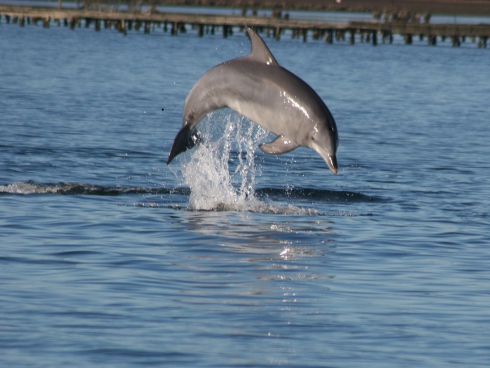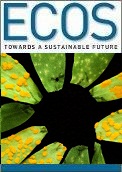
|
Published: 19 December 2011
Tourist boats interrupt dolphins’ daily life
Most humans love to interact with wildlife, especially with charismatic animals such as dolphins. While contact with these creatures is often a unique and incredible experience for us, it is important to realise that ‘watching’ activity can have an adverse effect on the dolphins themselves.

|
|
Dolphin-watching boat activity can alter key dolphin behaviour and must be carefully regulated. Credit: Andre Steckenreuter
|
In cases where human–wildlife interactions turn into large-scale tourism industries, research shows that these activities can negatively impact wildlife by, for example, disrupting resting or feeding. Wildlife tourism therefore needs regulations aiming to ensure both a healthy wild population of animals and satisfactory wildlife encounters for humans.
The legislation for dolphin-watching in Australia is bound to a regulatory framework that addresses how boats must behave around pods of dolphins. For example, boats are required to remain a minimum distance away from dolphins; this varies depending on whether dolphin calves are in a pod. The regulations also dictate how boats may approach dolphins, e.g. boats must not cut dolphins off. However, management agencies responsible for a given area can adapt the boating regulations to their local circumstances.
My research as a PhD student at Macquarie University has focused on the impact of dolphin-watching vessels on the behaviour of a resident population of around 100 Indo-Pacific bottlenose dolphins (Tursiops aduncus) in the Port Stephens–Great Lakes Marine Park (PSGLMP), New South Wales. Commercial dolphin-watching tours started here in the early 1990s, and up to 15 boats can operate per day. The tours are restricted to the eastern embayment of the marine park (an area of around 50 km²). Around 70 per cent of the dolphin population live in this area, and so human-wildlife interactions are intensified for the majority of the dolphin population in the marine park.
In Port Stephens, industry had requested an exemption to allow closer approaches to dolphin pods. My aims were to investigate the impacts of dolphin-watching vessels on dolphin behaviour in the PSGLMP, how boat distance affected dolphin behavioural changes, and whether implemented speed restriction zones were an appropriate management tool.
My research showed that dolphins changed their behaviour dramatically when dolphin-watching vessels approached them. Dolphins stopped resting, and spent considerably less time feeding in the presence of dolphin-watching vessels. This may alter dolphins’ energy expenditure and in the long term may affect the health of individual animals, their reproductive success and ultimately the population.
The behavioural changes were exacerbated when boats approached closer, or when the number of boats increased. Dolphins used speed restriction zones less during intense boat traffic, which indicates that the zones as currently specified by the Marine Parks Authority NSW do not effectively minimise boating impacts.
The good news is, however, that a long-term study of abundance in Port Stephens by a fellow student at Macquarie University, Caroline Waring, does not indicate the population is declining.
Based on these findings, I recommended to the Marine Parks Authority NSW management that regulations in the PSGLMP should more closely cohere with national dolphin-watching regulations. The national regulations insist on a greater distance from the dolphins and include a stricter framework for the approach of dolphin-watching vessels. I also recommended that the location, size and accompanied regulations of speed restriction zones should be revised.
The findings of this study are not only important for the management of the local marine park, but will be relevant to all similar industries that must ensure benign and viable dolphin tourism activities. However, we have to keep in mind that we cannot expect to have a panacea regarding these issues. Each population of animals is likely to react differently to human interactions.
Resident populations of dolphins that depend on a limited home range and use only a small area as their habitat are most likely to be encountered by humans several times a day. Because of this, they may react completely differently to disturbance than migratory species, such as humpback whales, which on a single migration are unlikely to encounter more than one or two boats during their entire journey. Disturbance by tourism vessels may be very different for dolphins that have a much larger home range and might shift to different areas with similar resources.
Many people may now think, ‘Hang on, whenever I see dolphins in the wild, they are happily jumping and riding the waves around the boat! How can they be adversely affected by these encounters?’ This is a very legitimate question. For one thing, every individual dolphin is different – similar to humans, some of who are more curious or playful than others. And secondly, dolphin populations vary considerably. Some, such as the Port Stephens’ dolphins, are small and live in a very small area, in which case they may be subject to repeated interactions on a daily basis; others range in much larger areas, and so interactions with each individual in the population are much less frequent.
The research in the PSGLMP showed that dolphins actively avoided approaching dolphin-watching vessels. However, dolphins reacted very differently towards sailing or other recreational boats. This may be due to their ability to distinguish between different engine noises; thus, they may recognise dolphin-watching vessels by their sound.
More important, however, is that dolphin-watching vessels behave very differently towards dolphins. Recreational boaters may be on a straight line going from A to B. In this case, curious individuals of the pod travelling the same direction may join boats for a while, as they can reduce their energy expenditure by riding in the generated pressure wave of the boat. Dolphin-watching vessels instead try to approach the animals directly, and may approach them from angles that are perceived as threatening to dolphins, especially those caring for offspring. Dolphins may perceive such encounters similarly to predation risk and try to avoid them by horizontal or vertical movements away from the source of risk.
It is vitally important to have appropriate management procedures and legislation in place where interactions with wildlife are potential threats to animal populations, and is our responsibility to act accordingly during these interactions. The choice of the right tourism operator may play an important role in a satisfactory experience for the visitor. Operators who are knowledgeable and responsible while interacting with wildlife will respect regulations regarding those encounters, guaranteeing the sustainability of their industry and the viability of a healthy population of the targeted species.
Andre Steckenreuter is a PhD researcher at the Graduate School of Environment, Faculty of Science, at Macquarie University, Sydney, NSW. This article summarises key findings of three recent research papers:
Steckenreuter A, Harcourt R, Möller L (2011). Distance does matter: close approaches by boats impede feeding and resting behaviour of Indo-Pacific bottlenose dolphins. Wildlife Research 38: 455-463.
Steckenreuter A, Harcourt R, Möller L. (2012). Are Speed Restriction Zones an effective management tool for minimising impacts of boats on dolphins in an Australian marine park? Marine Policy 36: 258-264.
Steckenreuter A, Möller L, Harcourt R. (In press). How does Australia’s largest dolphin-watching industry affect the behaviour of Indo-Pacific bottlenose dolphins? Journal of Environmental Management.





